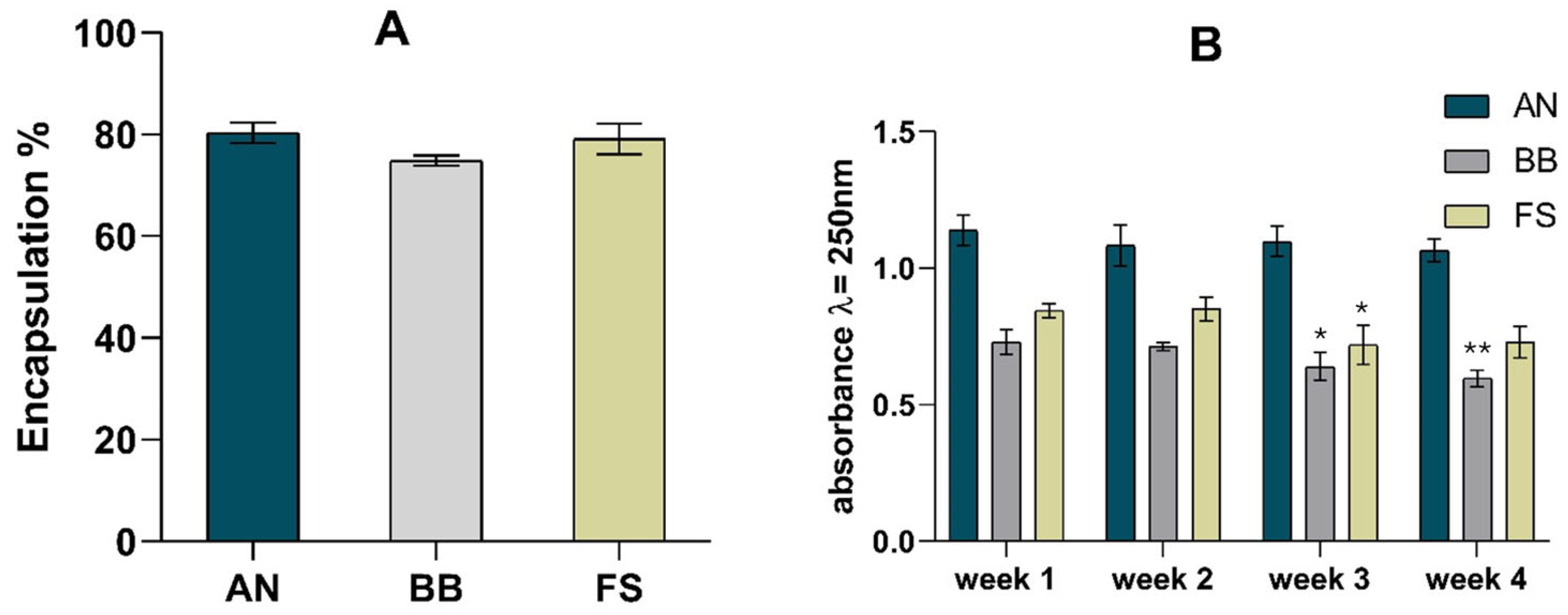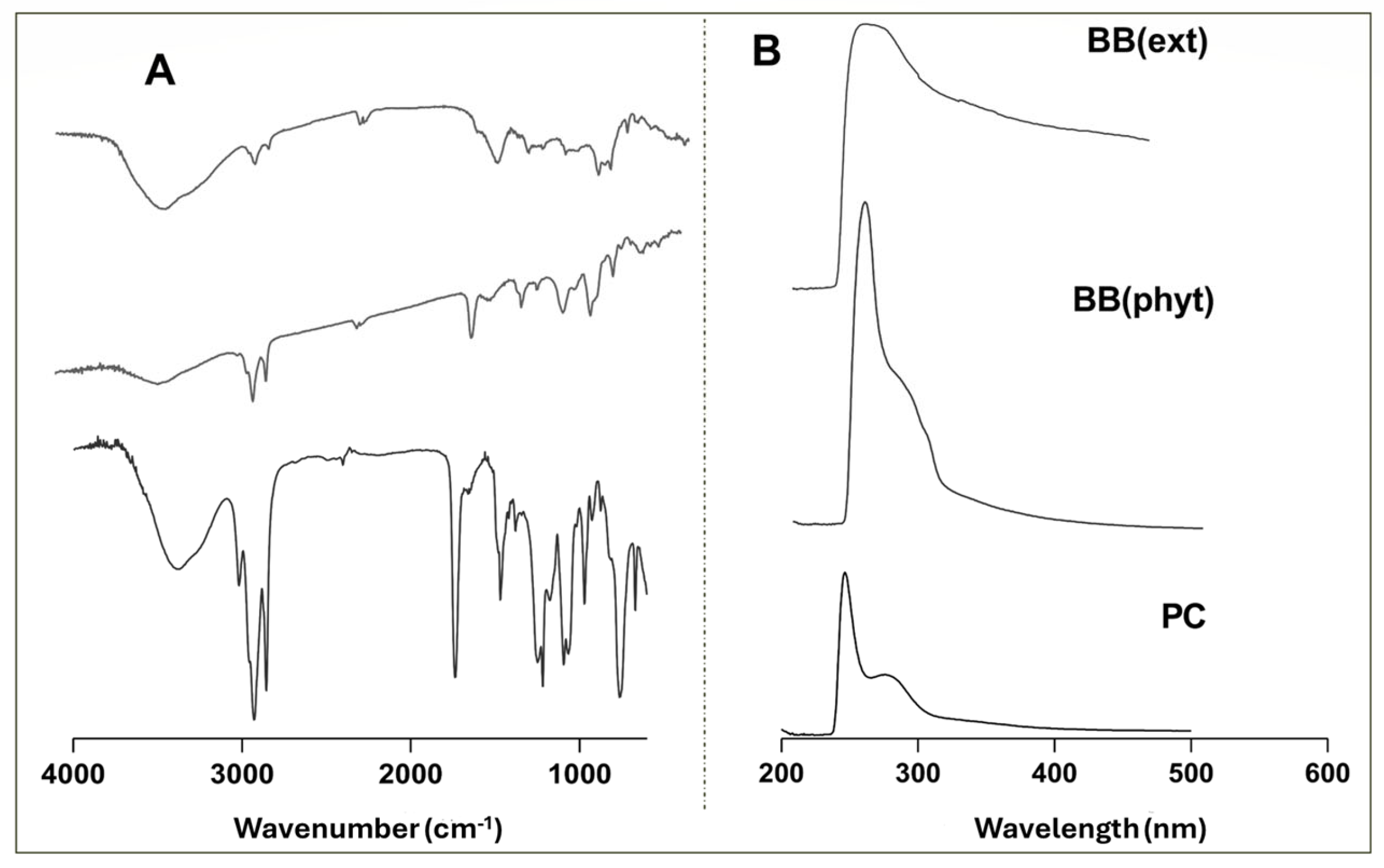Phytosomes-Based Nanocarriers Enhanced with Seaweed Extracts: Overcoming the Blood–Brain Barrier †
Abstract
1. Introduction
2. Materials and Methods
2.1. Algae Extraction
2.2. Phytosome Production and Stability
2.3. Phytosome Characterization
2.4. hCMEC/D3 Cells Model of the Blood–Brain Barrier (BBB)
2.5. Statistical Analysis
3. Results and Discussion
3.1. Entrapment Rate
3.2. Phytosome Characterization
3.3. In Vitro Effectiveness of Phytosomes’ Ability to Cross the BBB
4. Conclusions
Author Contributions
Funding
Data Availability Statement
Acknowledgments
Conflicts of Interest
References
- Grosso, C.; Silva, A.; Delerue-Matos, C.; Barroso, M.F. Single and Multitarget Systems for Drug Delivery and Detection: Up-to-Date Strategies for Brain Disorders. Pharmaceuticals 2023, 16, 1721. [Google Scholar] [CrossRef] [PubMed]
- Pandian, S.R.K.; Vijayakumar, K.K.; Murugesan, S.; Kunjiappan, S. Liposomes: An Emerging Carrier for Targeting Alzheimer’s and Parkinson’s Diseases. Heliyon 2022, 8, e09575. [Google Scholar] [CrossRef]
- Seo, M.W.; Park, T.E. Recent Advances with Liposomes as Drug Carriers for Treatment of Neurodegenerative Diseases. Biomed. Eng. Lett. 2021, 11, 211–216. [Google Scholar] [CrossRef] [PubMed]
- Kim, A.Y.; Al Jerdi, S.; MacDonald, R.; Triggle, C.R. Alzheimer’s Disease and Its Treatment–Yesterday, Today, and Tomorrow. Front. Pharmacol. 2024, 15, 1399121. [Google Scholar] [CrossRef]
- Guo, J.; Qi, M.; Chen, H.; Zhou, C.; Ruan, R.; Yan, X.; Cheng, P. Macroalgae-Derived Multifunctional Bioactive Substances: The Potential Applications for Food and Pharmaceuticals. Foods 2022, 11, 3455. [Google Scholar] [CrossRef]
- Rico, M.; González, A.G.; Santana-Casiano, M.; González-Dávila, M.; Pérez-Almeida, N.; de Tangil, M.S. Production of Primary and Secondary Metabolites Using Algae. In Prospects and Challenges in Algal Biotechnology; Springer Singapore: Singapore, 2017; pp. 311–326. [Google Scholar]
- Ambiga, S.; Pandian, R.S.; Lawrence, L.V.; Pandian, A.; Kumar, R.A.; Abdul, B.A.A. Marine Algal Secondary Metabolites Are a Potential Pharmaceutical Resource for Human Society Developments. In Marine Biochemistry; CRC Press: Boca Raton, FL, USA, 2022; pp. 339–362. [Google Scholar]
- Silva, J.; Alves, C.; Freitas, R.; Martins, A.; Pinteus, S.; Ribeiro, J.; Gaspar, H.; Alfonso, A.; Pedrosa, R. Antioxidant and Neuroprotective Potential of the Brown Seaweed Bifurcaria Bifurcata in an in Vitro Parkinson’s Disease Model. Mar. Drugs 2019, 17, 85. [Google Scholar] [CrossRef]
- Dobrinčić, A.; Balbino, S.; Zorić, Z.; Pedisić, S.; Kovačević, D.B.; Garofulić, I.E.; Dragović-Uzelac, V. Advanced Technologies for the Extraction of Marine Brown Algal Polysaccharides. Mar. Drugs 2020, 18, 168. [Google Scholar] [CrossRef]
- Pereira, L.; Morrison, L.; Shukla, P.S.; Critchley, A.T. A Concise Review of the Brown Macroalga Ascophyllum nodosum (Linnaeus) Le Jolis. J. Appl. Phycol. 2020, 32, 3561–3584. [Google Scholar] [CrossRef]
- Grina, F.; Ullah, Z.; Kaplaner, E.; Moujahid, A.; Eddoha, R.; Nasser, B.; Terzioğlu, P.; Yilmaz, M.A.; Ertaş, A.; Öztürk, M.; et al. In Vitro Enzyme Inhibitory Properties, Antioxidant Activities, and Phytochemical Fingerprints of Five Moroccan Seaweeds. S. Afr. J. Bot. 2020, 128, 152–160. [Google Scholar] [CrossRef]
- Shrestha, S.; Zhang, W.; Smid, S.D. Phlorotannins: A Review on Biosynthesis, Chemistry and Bioactivity. Food Biosci. 2021, 39, 100832. [Google Scholar] [CrossRef]
- Alqahtani, M.S.; Kazi, M.; Alsenaidy, M.A.; Ahmad, M.Z. Advances in Oral Drug Delivery. Front. Pharmacol. 2021, 12, 618411. [Google Scholar] [CrossRef] [PubMed]
- Hosseini, S.F.; Ramezanzade, L.; McClements, D.J. Recent Advances in Nanoencapsulation of Hydrophobic Marine Bioactives: Bioavailability, Safety, and Sensory Attributes of Nano-Fortified Functional Foods. Trends Food Sci. Technol. 2021, 109, 322–339. [Google Scholar] [CrossRef]
- Cascione, M.; De Matteis, V.; Leporatti, S.; Rinaldi, R. The New Frontiers in Neurodegenerative Diseases Treatment: Liposomal-Based Strategies. Front. Bioeng. Biotechnol. 2020, 8, 566767. [Google Scholar] [CrossRef]
- Bhagyashree, H.A.P. Phytosome as a Novel Biomedicine: A Microencapsulated Drug Delivery System. J. Bioanal. Biomed. 2015, 7, 6–12. [Google Scholar] [CrossRef]
- Mehmood, H. Phytosome as a Novel Carrier for Delivery of Phytochemicals: A Comprehensive Review. Middle East J. Appl. Sci. Technol. 2023, 6, 21–51. [Google Scholar] [CrossRef]
- Chaudhary, K.; Rajora, A. Phytosomes: A Critical Tool for Delivery of Herbal Drugs for Cancer. Phytochem. Rev. 2024, 24, 165–195. [Google Scholar] [CrossRef]
- Kanojiya, D.; Parmar, G.; Chauhan, B.; Gondalia, S.; Rakholiya, M. Phytosomes: A Contemporary Method for Delivering Novel Herbal Drugs. J. Nat. Remedies 2024, 24, 239–253. [Google Scholar] [CrossRef]
- Ozay, C.; Karpuz, M. Phytocompounds and Lipid-Based Drug Delivery System for Neurodegenerative Diseases. Asian Pac. J. Trop. Biomed. 2024, 14, 417–426. [Google Scholar] [CrossRef]
- Thomas, N.V.; Kim, S.-K. Potential Pharmacological Applications of Polyphenolic Derivatives from Marine Brown Algae. Environ. Toxicol. Pharmacol. 2011, 32, 325–335. [Google Scholar] [CrossRef]
- Barani, M.; Sangiovanni, E.; Angarano, M.; Rajizadeh, M.A.; Mehrabani, M.; Piazza, S.; Gangadharappa, H.V.; Pardakhty, A.; Mehrbani, M.; Dell’Agli, M.; et al. Phytosomes as Innovative Delivery Systems for Phytochemicals: A Comprehensive Review of Literature. Int. J. Nanomed. 2021, 16, 6983–7022. [Google Scholar] [CrossRef]
- Wong, K.H.; Riaz, M.K.; Xie, Y.; Zhang, X.; Liu, Q.; Chen, H.; Bian, Z.; Chen, X.; Lu, A.; Yang, Z. Review of Current Strategies for Delivering Alzheimer’s Disease Drugs Across the Blood-Brain Barrier. Focus 2022, 20, 117–136. [Google Scholar] [CrossRef] [PubMed]
- Wu, D.; Chen, Q.; Chen, X.; Han, F.; Chen, Z.; Wang, Y. The Blood–Brain Barrier: Structure, Regulation, and Drug Delivery. Signal Transduct. Target. Ther. 2023, 8, 217. [Google Scholar] [CrossRef] [PubMed]
- Mancini, S.; Nardo, L.; Gregori, M.; Ribeiro, I.; Mantegazza, F.; Delerue-Matos, C.; Masserini, M.; Grosso, C. Functionalized Liposomes and Phytosomes Loading Annona Muricata L. Aqueous Extract: Potential Nanoshuttles for Brain-Delivery of Phenolic Compounds. Phytomedicine 2018, 42, 233–244. [Google Scholar] [CrossRef]
- Suk, J.S.; Xu, Q.; Kim, N.; Hanes, J.; Ensign, L.M. PEGylation as a Strategy for Improving Nanoparticle-Based Drug and Gene Delivery. Adv. Drug Deliv. Rev. 2016, 99, 28–51. [Google Scholar] [CrossRef]
- Mehta, P.; Shende, P. Evasion of Opsonization of Macromolecules Using Novel Surface-Modification and Biological-Camouflage-Mediated Techniques for next-Generation Drug Delivery. Cell Biochem. Funct. 2023, 41, 1031–1043. [Google Scholar] [CrossRef]
- Michielin Lopes, C.; de Camargo, R.W.; Bitencourt, R.M. Doenças Neurodegenerativas e Canabinoides: Revisão Narrativa. Rev. Neurociências 2023, 31, 1–27. [Google Scholar] [CrossRef]
- Cassani, L.; Silva, A.; Carpena, M.; Pellegrini, M.C.; García-Pérez, P.; Grosso, C.; Barroso, M.F.; Simal-Gandara, J.; Gómez-Zavaglia, A.; Prieto, M.A. Phytochemical Compounds with Promising Biological Activities from Ascophyllum Nodosum Extracts Using Microwave-Assisted Extraction. Food Chem. 2024, 438, 138037. [Google Scholar] [CrossRef]
- Silva, A.; Carpena, M.; Cassani, L.; Grosso, C.; Garcia-Oliveira, P.; Delerue-Matos, C.; Simal-Gandara, J.; Barroso, M.F.; Prieto, M.A. Optimization and Bioactive Evaluation of Bifurcaria Bifurcata Antioxidant-Rich Extracts for Functional Food and Pharmaceutical Applications. Antioxidants 2024, 13, 1189. [Google Scholar] [CrossRef]
- Costa, M.; Soares, C.; Silva, A.; Grosso, C.; Delerue-Matos, C. Characterization of Codium Tomentosum Phytosomes and Their Neuroprotective Potential. Biol. Life Sci. Forum 2022, 18, 35. [Google Scholar]
- Costa, M.; Soares, C.; Silva, A.; Barroso, M.F.; Simões, P.; Ferreira, M.; Gameiro, P.; Grosso, C.; Delerue-matos, C. Optimization of Nanoencapsulation of Codium Tomentosum Extract and Its Potential Application in Yogurt Fortification. Mar. Drugs 2025, 24, 147. [Google Scholar] [CrossRef]
- Kumar, S.; Baldi, A.; Sharma, D.K. Characterization and In Vitro Investigation of Antiscabietic Effect of Phytosomes Assimilating Quercetin and Naringenin Rich Fraction of Pistacia Integerrima Galls Extract against Sarcoptes Scabiei. J. Drug Deliv. Sci. Technol. 2022, 67, 102851. [Google Scholar] [CrossRef]
- Cayero-Otero, M.D.; Gomes, M.J.; Martins, C.; Álvarez-Fuentes, J.; Fernández-Arévalo, M.; Sarmento, B.; Martín-Banderas, L. In Vivo Biodistribution of Venlafaxine-PLGA Nanoparticles for Brain Delivery: Plain vs. Functionalized Nanoparticles. Expert Opin. Drug Deliv. 2019, 16, 1413–1427. [Google Scholar] [CrossRef] [PubMed]
- Soliman, T.N.; Negm El-Dein, A.; Abd Al-Daim, S.; Allayeh, A.; Awad, H.; Flefil, N.S. Characterization of C-Phycocyanin Antioxidant, Anti-Inflammatory, Anti-Tumour, and Anti-HCoV-229E Activities and Encapsulation for Implementation in an Innovative Functional Yogurt. Heliyon 2024, 10, e31642. [Google Scholar] [CrossRef] [PubMed]
- Mittal, P.; Singla, M.; Smriti; Kapoor, R.; Kumar, D.; Gupta, S.; Gupta, G.; Bhattacharya, T. Paclitaxel Loaded Capmul MCM and Tristearin Based Nanostructured Lipid Carriers (NLCs) for Glioblastoma Treatment: Screening of Formulation Components by Quality by Design (QbD) Approach. Discov. Nano 2024, 19, 175. [Google Scholar] [CrossRef]
- Direito, R.; Reis, C.; Roque, L.; Gonçalves, M.; Sanches-Silva, A.; Gaspar, M.M.; Pinto, R.; Rocha, J.; Sepodes, B.; Rosário Bronze, M.; et al. Phytosomes with Persimmon (Diospyros kaki L.) Extract: Preparation and Preliminary Demonstration of In Vivo Tolerability. Pharmaceutics 2019, 11, 296. [Google Scholar] [CrossRef]
- Semalty, A.; Tanwar, Y.S.; Singh, D.; Rawat, M.S.M. Phosphatidylcholine Complex in Improving Oral Drug Delivery of Epicatechin: Preparation and Characterization. Drug Discov. Dev. 2014, 1, 46–55. [Google Scholar]
- Rabanel, J.-M.; Hildgen, P.; Banquy, X. Assessment of PEG on Polymeric Particles Surface, a Key Step in Drug Carrier Translation. J. Control. Release 2014, 185, 71–87. [Google Scholar] [CrossRef]
- Rajamma, S.S.; Krishnaswami, V.; Prabu, S.L.; Kandasamy, R. Geophila Repens Phytosome-Loaded Intranasal Gel with Improved Nasal Permeation for the Effective Treatment of Alzheimer’s Disease. J. Drug Deliv. Sci. Technol. 2022, 69, 103087. [Google Scholar] [CrossRef]


| Phytosomes | Average Size (nm) | Polydispersity | Zeta Potential (mV) |
|---|---|---|---|
| AN (phyt) | 168 ± 18 c | 0.286 ± 0.019 b | 2.22 ± 0.52 a |
| AN (PEG) | 366± 34 a | 0.587 ± 0.138 a | 0.63 ± 0.47 b |
| AN (ApoE3/PEG) | 277 ± 38 b | 0.389 ± 0.013 a,b | −0.68 ± 0.26c |
| BB (phyt) | 151 ± 60 | 0.395 ± 0.086 a | 2.15 ± 0.12 a |
| BB (PEG) | 297 ± 58 | 0.566 ± 0.032 a | 0.87 ± 0.58 a |
| BB (ApoE3/PEG) | 310± 86 | 0.539 ± 0.088 a | −3.31 ± 1.05 b |
| FS (phyt) | 118 ± 26 b | 0.411 ± 0.178 a | 1.91 ± 0.10 a |
| FS (PEG) | 254 ± 88 a,b | 0.685 ± 0.171 a | −7.27 ± 1.81 c |
| FS (ApoE3/PEG) | 361± 44 a | 0.419 ± 0.100 a | −2.30 ± 0.64 b |
| Phytosomes | Permeability (%) 3 h | Permeability (%) 24 h |
|---|---|---|
| AN (phyt) | 0.08 ± 0.03 b,B | 27.4 ± 0.9 a,A |
| AN (ApoE3/PEG) | 4.67 ± 0.03 a,B | 13.1 ± 0.4 b,A |
| BB-(phyt) | 3.76 ± 0.04 b,B | 22.9 ± 2.0 a,A |
| BB (ApoE3/PEG) | 4.60 ± 0.03 a,B | 12.5 ± 0.3 b,A |
| FS-(phyt) | 5.15 ± 0.04 a,B | 23.3 ± 0.6 A |
| FS (ApoE3/PEG) | 4.79 ± 0.03 b,B | 20.6 ± 2.1 A |
Disclaimer/Publisher’s Note: The statements, opinions and data contained in all publications are solely those of the individual author(s) and contributor(s) and not of MDPI and/or the editor(s). MDPI and/or the editor(s) disclaim responsibility for any injury to people or property resulting from any ideas, methods, instructions or products referred to in the content. |
© 2025 by the authors. Licensee MDPI, Basel, Switzerland. This article is an open access article distributed under the terms and conditions of the Creative Commons Attribution (CC BY) license (https://creativecommons.org/licenses/by/4.0/).
Share and Cite
Portela, M.; Silva, A.; Carpena, M.; Grosso, C.; Barroso, M.F.; Oliveira, A.I.; Martins, C.; Ribeiro, C.; Prieto, M.A. Phytosomes-Based Nanocarriers Enhanced with Seaweed Extracts: Overcoming the Blood–Brain Barrier. Eng. Proc. 2025, 87, 75. https://doi.org/10.3390/engproc2025087075
Portela M, Silva A, Carpena M, Grosso C, Barroso MF, Oliveira AI, Martins C, Ribeiro C, Prieto MA. Phytosomes-Based Nanocarriers Enhanced with Seaweed Extracts: Overcoming the Blood–Brain Barrier. Engineering Proceedings. 2025; 87(1):75. https://doi.org/10.3390/engproc2025087075
Chicago/Turabian StylePortela, Mariana, Aurora Silva, Maria Carpena, Clara Grosso, Maria Fátima Barroso, Ana Isabel Oliveira, Cláudia Martins, Cristina Ribeiro, and Miguel A. Prieto. 2025. "Phytosomes-Based Nanocarriers Enhanced with Seaweed Extracts: Overcoming the Blood–Brain Barrier" Engineering Proceedings 87, no. 1: 75. https://doi.org/10.3390/engproc2025087075
APA StylePortela, M., Silva, A., Carpena, M., Grosso, C., Barroso, M. F., Oliveira, A. I., Martins, C., Ribeiro, C., & Prieto, M. A. (2025). Phytosomes-Based Nanocarriers Enhanced with Seaweed Extracts: Overcoming the Blood–Brain Barrier. Engineering Proceedings, 87(1), 75. https://doi.org/10.3390/engproc2025087075











